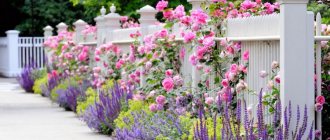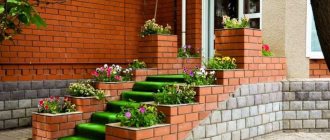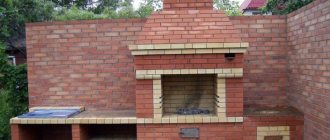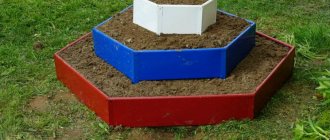- Why are brick borders attractive?
- We make a brick border;
- We prepare tools and materials;
- Location of brick borders;
- We make borders according to plan;
- Design solutions for laying brick borders;
- Options for borders in photographs.
Today we will look at how to make a beautiful brick border with your own hands quickly and efficiently. After all, the decoration of a site and its zoning largely depends on the borders. This is a fairly simple job and anyone can do it. Here you can use almost any material, it is fashionable to make a decorative brick border, use leftover tiles and much more. It is also quite possible to choose the desired ornament for paths and flower beds.
Design options
Using bricks you can create bright and original flower beds. You can turn fantasies of varying complexity into reality. Looking at photos of brick flower beds on the Internet will help you get ideas. A set of suitable tools, prepared material and the desire to bring the idea to life.
Depending on the location, the amount of building material, and the general style, you can choose a suitable design solution for decorating a brick flower bed.
The center of the open area on the site can be decorated with a round flowerbed. You can make it flat and plant low, bright flowers in it.
Tall plants will look better in a flowerbed with raised walls. The same location is suitable for an oval flower bed.
Rectangular brick flower beds can be placed along the house or paths. This option will effectively decorate the fence. The rectangle shape is used to visually increase the area.
Compositions of flowers look original if they are correctly arranged in flower beds of several tiers. The upper tier can be decorated with hanging species, and low-growing, soil-covering plants can be planted on the lower tier.
Choosing a location
The place for arranging the flower bed is chosen carefully, since further transfer or changes are possible only in case of complete dismantling.
You need to make sure that the view from the entrance to the estate focuses on it, the view opens from the porch of the house, from the gazebo, but at the same time this element of the landscape fits harmoniously into the surrounding landscape. Oval or round multi-tiered flower beds would be appropriate in the center of the garden or, for example, in front of a gazebo.
Concave and curved flat or raised edges and mixborders serve as an effective blind area near buildings, near a fence, attractive accents in remote corners that are inconvenient or difficult for other layouts, and hide minor shortcomings of buildings.
The traditional “brick” terracotta (reddish-brown) color looks great on almost any background
Combination with the overall style
If you decided to make a flowerbed out of brick with your own hands, then you should not forget about its harmonious combination with the general style of the site. To achieve this, you can add some decorative elements.
To combine with the classic style, it will be enough to add stones of the same size between the bricks.
Wooden elements will help the brick flower garden fit into the country style.
Shells and pebbles, as well as small stones in the flowerbed, are suitable for combination with an Art Nouveau style plot.
English track
There is such a term in landscape design. Essentially, these are paths made of old brick. They are laid without curbs or other restrictions. That is, a path is formed in the form of a ditch, where sand is poured, and old bricks are laid on top of it. Their upper plane should be located at the level of the ground or be slightly higher.
This is the simplest option that does not require large amounts of money and time. The only requirement is that there is no vegetation that would grow between the cladding elements. Therefore, the bottom of the dug ditch is covered with geotextiles. This material will not allow plants to break through, but it allows water to pass through it well. Geotextiles are laid so that they cover the walls of the pit.
If this non-woven material is not available, then a gap of 1-2 cm is left between the bricks, which is subsequently filled with cement-sand mortar. Just such an option is shown in the photo below.
English brick path Source pinterest.com
Brick border
You can define the boundaries of a flower bed using a brick border. This is the easiest way to build a brick flower bed in a country house.
- A DIY mailbox is a beautiful decoration and a useful addition to a suburban area
A house for children is a place where a fairy tale becomes reality, we create it ourselves
Bridges for a dacha - a picturesque element of the landscape in a suburban area
Not much material goes into it, but this type of masonry is done easily and quickly. The diagonal arrangement looks interesting. With it, one of the angles determines the top point.
To lay the curb, a rope is pulled and a shallow trench is dug. The brick is laid out and the gaps are filled. Then the brick should be compacted.
Such a structure is mainly decorative in nature, since it does not even retain water very well.
What should you pay attention to?
When constructing a garden border from brick blocks, you need to take into account some of the features of this building material.
When laying a fencing structure, just as when using natural stones, the base is made solid, and a cement mortar prepared in accordance with the required proportions is used as a fastening. It is better to choose facing bricks for the border, as they are considered more resistant to bad weather conditions. The fence, which is intended to divide the garden area into separate zones, must have a low, flat edge on the lawn side so that the lawn mower wheel glides smoothly across the grass. When choosing inclined masonry for installing a brick border (like teeth), it is important to take into account the fact that this type of edging has less strength and durability. In conditions of high humidity, brick laid with teeth is subject to collapse and destruction.
Construction process
Having built beautiful flower beds on your site yourself, it is doubly pleasant to admire them in the future. If you have chosen a design option and everything is prepared, you can begin to apply markings. For this, rope or twine and stakes are used.
The rope is tensioned and at the desired height. You can apply the outline with sand. According to the markings, a ditch is dug out. Its depth should be at least 30 cm for a wall five bricks high.
The higher the wall, the deeper you need to dig. Several tiers will require a depth of at least 80 cm.
Then a sand layer is poured. The next layer is crushed stone. It’s worth finishing with baking again. Each layer should be approximately five centimeters.
The layers are compacted and the first layer of brick is laid. Such a base will provide stability and serve as good drainage. Water will be able to flow freely, which will protect the roots of plants from rotting.
The first three layers of bricks, which are laid on top of each other without cement, will perform the same function. You can completely fold the flowerbed without using cement. But this option will last less.
The fourth and subsequent layers are laid on cement. The solution must be allowed to dry. It is recommended to start filling the finished flowerbed with soil no earlier than 4-5 days after laying.
In order to avoid expansion of the flowerbed under soil pressure from overgrown plants, when laying it, the bricks are slightly shifted inward, forming a barely noticeable shape of the pot. This will help maintain the original shape of the flowerbed longer.
Materials for production
Garden borders are made from various materials, so you can implement any decorative idea. Typically, fences are made of concrete, stone, brick, ceramics, plastic, wood and metal. To make a concrete garden border yourself, you need to prepare the following:
- cement composition of grade M400, M500;
- crushed stone or gravel (with a fraction of up to 40 mm);
- large river or washed sand;
- plasticizer or liquid composition for washing;
- much water;
- pigment type dye.
You will also need funds to form the formwork. It can be made from sheet metal, plywood or wooden boards. If you don't have time, just buy it at the store.
To secure the formwork components, metal pins, nails and bars are required. Concrete fencing can be strengthened using reinforcement with a rod diameter of 6 mm. The reinforcement is connected using a binding wire.
Filling the flowerbed
After the cement has dried, you can fill in the soil. It should not be compacted. It will be enough to water it generously and leave it for two weeks. After this period, it will be clear whether more soil needs to be added.
When the soil is ready, you can begin planting flowers and arranging decorative elements.
Borders for flower beds: analysis of 3 ways to arrange them yourself
It is difficult to imagine a summer suburban area without a wildly blooming garden. Tall velvet roses and peonies peek through the windows, small daisies and pansies are scattered in the grass, asters and hyacinths create unusual patterns in the flower beds. To frame bright flower arrangements, use borders for flower beds - low fences made of various materials. Let's figure out how to make fences from plastic, wood and brick.
What fencing options are there?
Even before you plant a flower garden, you should think about how to make a beautiful border for your flower bed. It should not only serve as the border of the flower structure, but also correspond to the general style of the surrounding area.
Border mosaic looks elegant and noble, and has one attractive quality - it is unique. Using glass and tile shards, you can create a unique, original design or ornament, and you can be sure that you will not find another flower bed frame like this. Instead of fragments, you can use regular or painted pebbles.
The flowerbed itself and the base of the bench are decorated with multi-colored mosaics. For the work we used pieces of ceramic facing tiles - a few pieces always remain after repairs
When creating a Mediterranean or English style in your garden, you can opt for fences made of natural stone: granite, shell rock, limestone, sandstone. They are equally good for decorating free-standing plants and for decorating large landscape flower beds. Strong and durable, stone structures will last for decades, and they are also easy to make yourself using cement mortar for construction.
A stylish look can be easily created by choosing a stone for the border to match the color of the surrounding buildings. Instead of natural material, you can use decorative tiles
Those who are seriously involved in gardening are familiar with this type of fencing for flower beds, known as a dug-out border. This is a kind of ditch dug between the flowerbed and the lawn (or path). The size of the dividing trench depends on the density of the soil and the root system of the plants.
The dug-out border needs regular care: mulching with peat or crushed wood chips, leveling, cutting off overgrown turf roots with special scissors
A wicker border looks interesting and is great for areas arranged in a rustic style. To make it, ordinary willow rods are used, attached to posts driven into the ground. Weaving is a traditional ancient method that our ancestors used to create village fences - wattle fences.
A living border of low ornamental plants looks natural. In addition to herbs and flowers, low-growing shrubs are successfully used. The height of the fence can be any, but usually it does not exceed 40 cm, otherwise the fence will cover the flower garden.
Low-growing green perennials can be replaced with any bright flowers with small inflorescences, thus creating beautiful compositions in an unusual frame
Option #1 – wooden fence made of pegs
For many summer residents, their suburban area is a real wooden kingdom: the house, outbuildings, bathhouse, gazebo, and even benches in the garden are made of wood. This is not surprising, because wood is a natural material that harmoniously combines with green spaces, flowers, stone paths and ponds. It is great for creating any country decorations, including making a decorative border for a flower bed.
To decorate flower beds, wooden elements of various sizes and shapes are used: small stumps, pegs from branches, old boards, remnants of bars
One of the simplest options available even to an amateur is a low fence made of pegs of various lengths. As a basis, we will take small, light wooden posts, the color of which can be changed to darker or brighter if necessary. The steps for creating a fence from pegs are extremely simple.
Preparation of building material
The blanks can be either wooden blocks of the same cross-section, or thick straight branches, which must be prepared in advance. We remove the bark from the branches and cut them into elements of various lengths. The dimensions of the products depend on the shape of the fence. In our case, these are alternating high and low bars. Let one part of the blanks be 0.30 m long, the second – 0.35 m.
We measure the length of the border and calculate the approximate number of products. We carefully treat each part with an antiseptic or a special protective varnish - this way the border will last much longer.
It is not difficult to find blanks for a wooden fence: if there are no fallen trees on the site, you can use materials left over after the construction of the fence
Digging a trench around the perimeter of the flower bed
In order not to confuse ourselves with installing each peg separately, we dig a groove about 0.15 m deep. To maintain accuracy, we first outline the outline of the fence - draw a line on the ground with a sharp object.
When digging a trench, you don’t need to make it too wide: in a narrow groove the pegs will be fixed more rigidly and firmly
Installation of pegs
We place the fencing elements one by one into the trench and immediately bury them, thoroughly compacting the soil. We alternate - first a short peg, then a long one. If the elements differ in thickness, then we try to alternate different blanks so that the fence as a whole looks more uniform.
Alternating installation of pegs makes it possible to carefully secure each workpiece on all sides. No special tools are required to compact the soil; just trample it with your feet.
After installing all the pegs and securing them, you can slightly change the height of the parts using a hammer. The pegs do not have to be different in height - many people like even fences made of the same elements
Final decoration of the border
If light wood does not fit well with the design of surrounding objects, it must be coated with paint of the desired shade: any tone of brown, yellow or gray. An excellent option is a special protective impregnation, which at the same time preserves the wood structure.
To preserve the natural texture of the wood, you can use a clear varnish or similar oil that protects the wood from swelling, mold and mildew.
Option #2 – building a brick border
If your country cottage is built of brick, you shouldn’t even think about making a border for your flowerbed yourself. You can quickly and easily make a brick edging for flower beds, which looks quite natural, especially against the background of a fence or paths made of a similar material.
The brick border goes perfectly with the same walls or sidewalks, as well as with any trees, shrubs or flowers
Contour marking
To mark the perimeter of the flowerbed, any available material is suitable: a thick cord, a watering hose, a rope stretched over pegs (if the shape of the object is strictly geometric - for example, rectangular or hexagonal).
Preparing the trench
Directly along the marked contour we dig a shallow trench, the depth of which is approximately 0.15 m. The width of the groove should be slightly larger than the width of the brick - about 0.25 m.
Benefits of using bricks
You can create a flowerbed using bricks of different heights, diameters, and shapes. Each of the options will look beautiful and original in its own way.
A brick fencing of a flower bed is a good way to designate areas of the site. You can use materials of different colors, textures, shapes and successfully combine them.
Brick, as the main material, has a relatively reasonable cost. Sometimes it remains from the construction of a house or outbuildings. Perhaps it is the presence of bricks that were not used in construction that will prompt the creation of an original flower bed.
Brick is known for its durability. It will last a long time, and over time it will look even more interesting, acquiring a unique charm.
Therefore, a brick flower bed is an excellent solution for a summer cottage or area near a private house. Natural stone has the same qualities. However, such finished material will cost much more.
If the brick does not match the overall color of the site, you can always repaint it.
Coming up with and creating a beautiful flower bed is not that difficult. By independently bringing your own idea to life, doing all the work with soul, selecting and combining plants for your new flower garden, in the future it will be doubly pleasant to admire the beauty of the result.
Selection and planting of plants
Porous clay bars retain heat for a long time, due to which the soil in contact with them tends to overheat and dry out. You should choose vegetation that is resistant to such conditions and has a compact root system, since the feeding area will be limited. An important factor is the demands of “green residents” on lighting and soil composition. The problem can be solved to a certain extent by mulching and adding moisture-retaining gel balls, but be prepared for the fact that you will have to pay more attention to fertilizing and watering .
During installation, it is important to provide high-quality drainage to prevent water from stagnating in the ground.
Buy cultivars that will contrast favorably with the brutal “stone” background: with lush white, yellow, pink, scarlet, and blue petals. Plants with leaves or buds of wine, rust, bronze, red-brown shades will be visually lost in a terracotta brick flower bed and will blend in with it in color. Bright mixes of ampelous petunias, surfinias, diascias, lobelias, and calibrachoas will noticeably revive and transform the masonry.
For landscaping and filling voids, you can plant small periwinkle, verbena, duchesnea (Indian strawberry), grayish-blue carnation bushes, saxifrage, gargan bell, and add echeveria, sedum, and young to join them. If necessary, annual crops can be easily replaced with new ones.
Brick structures are also used for planting spicy green and berry crops, medicinal herbs
Small-flowered climbing roses - ramblers - take root well and will quickly decorate a flowerbed with numerous buds, for example, “Super Dorothy”, “Bobby James”, “Parade”, “Lady Godiva”, “Trese Trave”, “Failhenblow”.
Perennial shrubs will need shelter from freezing for the winter.
Keep in mind that large-leaved vines (maiden grapes, ivy, wood pliers) can completely cover a brick structure; in addition, they cling with adventitious roots and sucker tendrils, which can destroy the masonry over time.
Smooth edges
If this option was selected for a structure that “grows in height,” then the installation is done on the transverse edge. For low ones, the brick is placed on one side. This way you can create an even, smooth surface. You choose the width individually.
We recommend reading:
What you need for a comfortable holiday in the country.- Alpine slides in landscape design on a small plot: the best ideas and stages of implementation
How to make a country washbasin: examples of building a simple and convenient washbasin with your own hands (90 photos)
For example, a beautiful flower bed located in front of the house can be 1.5 bricks wide. In this case, the structure can be decorated with various pots and figurines.











